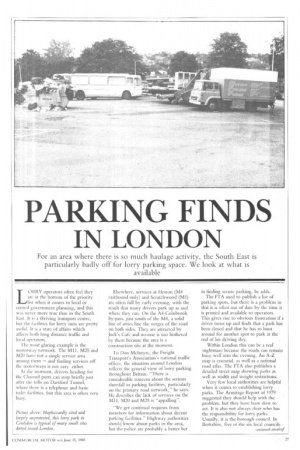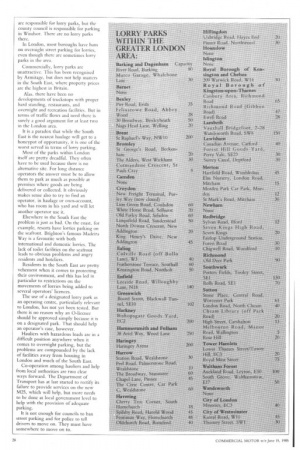PARKING FINDS
Page 29

Page 30

If you've noticed an error in this article please click here to report it so we can fix it.
IN LONDON
For an area where there is so much haulage activity, the South East is particularly badly off for lorry parking space. We look at what is available
Lo,,RY operators often feel they are at the bottom of the priority list when it comes to local or central government planning, and this was never more true than in the South East. It is a thriving transport centre, but the facilities for lorry men are pretty awful. It is ;i state of affairs which affects both long distance traffic and local operators.
The most glaring example is the motc>rway network. The M11, M25 and M20 have not a single service area among them — and finding services off the motorways is not easy either.
At the moment,. drivers heading for the Channel ports can stop briefly just after the tolls on Dartford Tunnel, where there is a telephone and basic toilet facilities, but this area is often very busy. Elsewhere, services at Heston (M4 eastbound only) and Scratchwood (M1) are often full by early evening, with the result that many drivers park up as and where they can. On the A4 Colnbrook by-pass, just south of the M4, a solid line of artics line the verges of the road on both sides. They are attracted by Jock's Cale and no-one is too bothered by them because the area is a construction site at the moment.
To Don McIntyre, the Freight Transport's Association's national traffic officer, the situation around London reflects the general view of lorry parking throughout Britain. "There is considerable concern about the serious shortfall in parking facilities, particularly on the primary road network," he says. He describes the tack of services on the MU, M20 and M25 is "appalling".
"We get continual requests from members for information about decent parking facilities," Highway authorities should know about parks in the area, but the police are probably a better bet in finding secure parking, he adds.
The FTA used to publish a list of parking spots, but there is a problem in that it is often out of date by the time it is printed and available to operators. This gives rise to obvious frustration if a driver turns up and finds that a park has been closed and that he has to hunt around for another spot to park at the end of his driving day.
Within London this can be a real nightmare because the roads can remain busy well into the evening. An A-Z map is essential, as well as a national road atlas. The FTA also publishes a detailed street map showing parks as well as width and weight restrictions.
Very few local authorities are helpfial when it comes to establishing lorry parks. The Armitage Report of 1979 • suggested they should help with the problem, but they have been slow to act. It is also not always clear who has the responsibility for lorry parks. Usually, it is the borough council. In Berkshire, five of the six local councils are responsible for lorry parks, but the county council is responsible for parking in Windsor. There are no lorry parks there.
In London, most boroughs have bans on overnight street parking for lorries, even though there are sometimes lorry parks in the area.
Commercially, lorry parks are unattractive. This has been recognised by Armitage, but does not help matters in the South East, where property prices are the highest in Britain.
Alas, there have been no developments of truckstops with proper hard standing, restaurants, and overnight and recreation facilities. But in terms of traffic flows and need there is surely a good argument for at least two in the London area.
It is a paradox that while the South East is the nearest haulage will get to a honeypot of opportunity, it is one of the worst served in terms of lorry parking.
Most of the parks within London itself are pretty dreadful. They often have to be used because there is no alternative site. For long distance operators the answer must be to allow them to park as much as possible at premises where goods are being delivered or collected. It obviously makes sense also to try to find an operator, in haulage or own-account, who has room in his yard and will let another operator use it.
Elsewhere in the South East the problem is just as bad. On the coast, for example, resorts have lorries parking on the seafront. Brighton's famous Madeira Way is a favourite with both international and domestic lorries. The lack of toilet facilities on the seafront leads to obvious problems and angry residents and hoteliers.
Residents in the South East are pretty vehement when it comes to protecting their environment, and this has led in particular to restrictions on the movements of lorries being added to several operators' licences.
The use of a designated lorry park as an operating centre, particularly relevant to London, has not yet been tested. But there is no reason why an 0-licence should be approved simply because it is on a designated park. That should help an operator's case, however.
Hauliers with hazardous loads are in a difficult position anywhere when it comes to overnight parking, but the problems are compounded by the lack of facilities away from housing in London and much of the South East.
Co-operation among hauliers and help from local authorities are two clear ways forward. The Department of Transport has at last started to rectify its failure to provide services on the new M25, which will help, but more needs to be done at local government level to help with the provision of adequate parking.
It is not enough for councils to ban street parking and for police to tell drivers to move on. They must have somewhere to move on to.




































































































